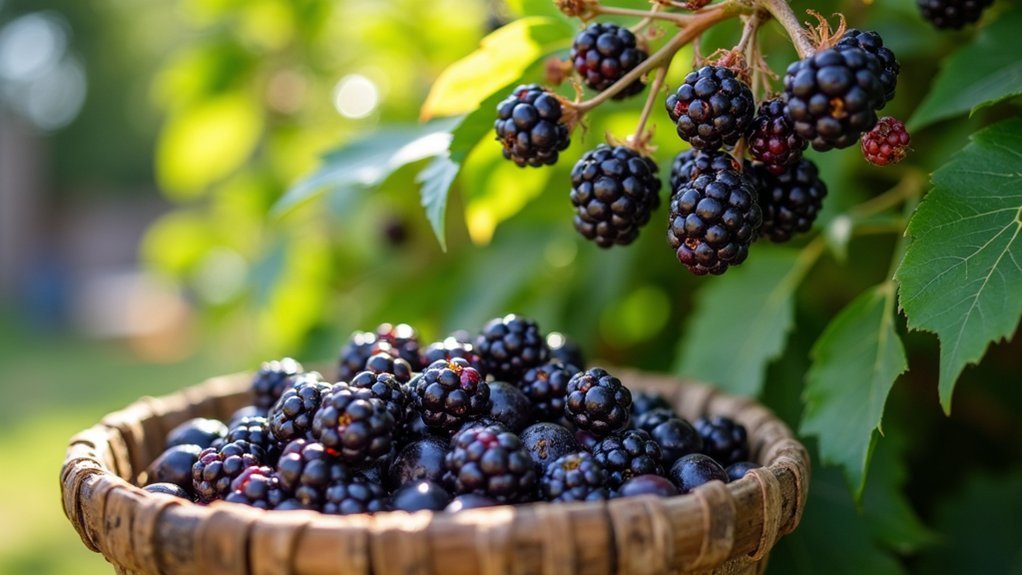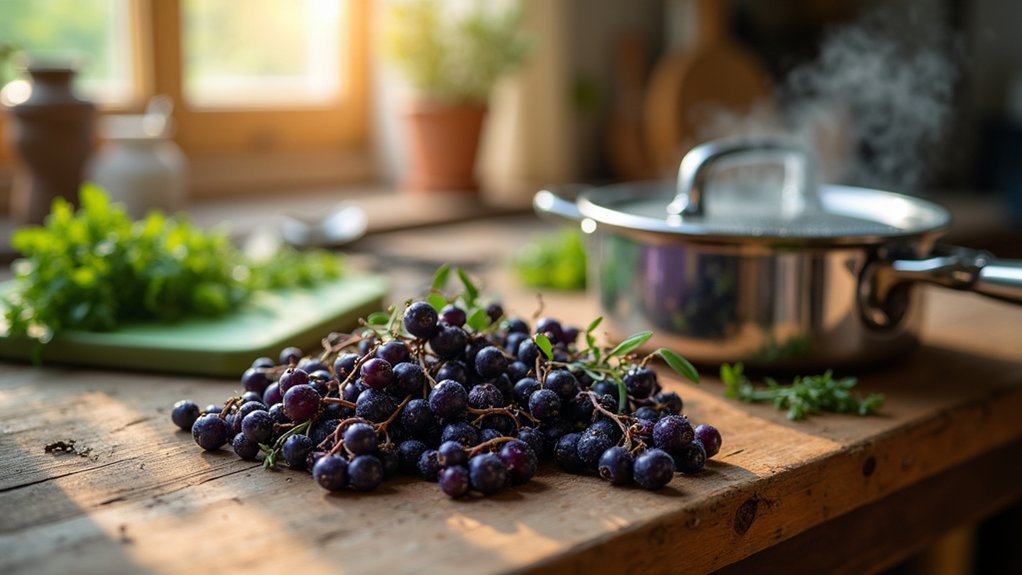To prepare fresh foraged elderberries, first identify and harvest only deep purple to black clusters, leaving stems behind. Next, clean thoroughly by rinsing in cold water and carefully remove berries from stems using a fork or your fingers. Finally, cook the berries properly by simmering for 15-20 minutes to neutralize toxic compounds. Never consume elderberries raw, as proper heat treatment transforms these foraged gems into safe, nutritious delicacies.
Identifying and Harvesting Ripe Urban Elderberries

Three key features distinguish ripe elderberries in urban environments: deep purple to black coloration, full clusters hanging heavy on shrubs, and their common presence near water sources or in hedgerows.
You'll find these fresh berries from late summer through early fall.
Never confuse edible blue/black elderberries with toxic red elderberries—the latter can cause serious health problems.
When harvesting, gently strip ripe elderberries from their stems using your fingers, as stems contain compounds that may cause digestive issues if consumed.
Select only plump, fully formed clusters and avoid any with shriveled or green berries.
After collection, thoroughly wash your elderberries in cold water to remove dirt, bugs, and debris.
Remember that proper identification and preparation are crucial—only cook fully ripe berries to guarantee they're safe to eat.
Cleaning and De-stemming Your Foraged Bounty
The most essential step after collecting elderberries is properly cleaning and removing them from their stems.
Begin by rinsing your foraged clusters in cold water to remove dirt and insects while keeping berries attached to stems.
Next, gently strip ripe berries using your fingers or a fork, discarding any unripe green berries and stems, which contain toxic compounds.
Thoroughly wash the separated berries again to eliminate any remaining debris.
For easier processing, work in small batches and use a bowl to catch berries as you remove them.
If you find de-stemming tedious, try freezing the elderberry clusters for a few hours—frozen berries detach from stems more readily, simplifying the task.
These careful cleaning steps guarantee your foraged elderberries are safe and ready for culinary or medicinal use.
Cooking Methods to Transform Toxic Berries Into Safe Delicacies

While elderberries offer exceptional flavor and health benefits, they require proper cooking to neutralize their toxic compounds.
Raw berries contain cyanogenic glycosides that must be destroyed through heat processing before they're safe to eat. Only use fully ripe blue or black elderberries—never red varieties or unripe berries.
Follow these proven cooking methods:
- Basic simmering – Cover elderberries with equal parts water and simmer for 15-20 minutes until soft.
- Elderberry syrup – After simmering, strain to remove the berries, then add honey and reduce to desired thickness.
- Safe canning – Add 2 tablespoons lemon juice per 4 cups of juice to guarantee proper acidity levels.
- Tea preparation – Dried ripe flowers can be steeped in hot water for a milder elderberry experience.
Frequently Asked Questions
How to Prepare Wild Elderberries?
To prepare wild elderberries, you'll need to harvest only blue/black ripe berries, strip them from stems, wash thoroughly, cook them completely to avoid toxicity, strain the mixture, and add sweetener if making syrup.
What Is the Best Way to Process Fresh Elderberries?
To process fresh elderberries, you'll need to strip berries from stems, rinse thoroughly, cook with equal water for 30 minutes, strain the mixture, then sweeten with honey or sugar for storage and use.
How to Clean Fresh Picked Elderberries?
You'll need to rinse elderberries on stems first, then remove berries using a fork. Soak them briefly to reduce stickiness, wash again in cold water, and dry thoroughly before using them.
How Do You Make Elderberries Safe to Eat?
To make elderberries safe to eat, you'll need to remove all stems, select only ripe blue/black berries, wash them thoroughly, and cook them completely. Cooking is essential as it destroys the toxic compounds in the seeds.
In Summary
Now you're ready to enjoy your urban elderberry harvest safely! Remember, you've learned to identify ripe clusters, properly remove those pesky stems, and cook the berries thoroughly to eliminate toxins. Don't skip the cooking step—it's essential for transforming these foraged gems into something delicious and safe. With these simple techniques, you'll confidently add wild elderberries to your seasonal cooking repertoire year after year.





Leave a Reply